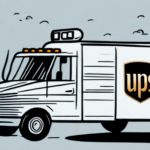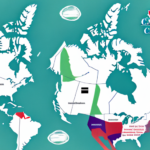Understanding UPS Shipping Rates to Canada
When it comes to shipping packages to Canada, UPS stands out as one of the most trusted and widely used carriers. Whether you're a business owner sending products to Canadian customers or an individual sending a heartfelt gift to a friend, comprehending UPS shipping rates and their structure is crucial. This comprehensive guide delves into everything you need to know about UPS shipping rates to Canada, enhanced with up-to-date information and insights.
What is UPS and How Does It Work in Canada?
UPS (United Parcel Service) is a global logistics and transportation powerhouse, operating in over 220 countries and territories, including Canada. As of 2023, UPS manages a vast domestic network within Canada, encompassing more than 400 facilities and 5 major gateways, facilitating efficient parcel movement across the country.
UPS offers a diverse range of shipping services tailored to various needs:
- Ground Shipping: Cost-effective option for non-urgent shipments.
- Air Freight: Fast delivery for time-sensitive packages.
- Ocean Freight: Suitable for large, bulky shipments.
One of UPS's standout features is its advanced tracking technology, enabling customers to monitor their shipments in real-time. According to a 2023 UPS Tracking report, over 99% of UPS shipments are tracked from origin to destination, providing transparency and peace of mind.
Beyond shipping, UPS provides comprehensive supply chain solutions, including inventory management, order fulfillment, and distribution services, aiding businesses in streamlining operations and enhancing efficiency. Furthermore, UPS is committed to sustainability, implementing initiatives like using alternative fuel vehicles and optimizing delivery routes to minimize carbon footprints. They also offer carbon-neutral shipping options, allowing customers to offset emissions associated with their shipments.
Factors Affecting UPS Shipping Rates to Canada
Several key factors influence UPS shipping rates to Canada:
- Package Weight and Dimensions: Heavier and larger packages incur higher shipping costs. For instance, moving from a 5 lb to a 20 lb package can significantly increase the rate.
- Destination: Shipping to remote or rural areas may attract additional fees compared to urban centers.
- Service Level: Expedited services like Next Day Air are more costly than standard ground shipping.
- Customs Fees and Duties: International shipments are subject to Canadian customs regulations, which may include taxes and duties based on the shipment's value and nature.
- Type of Goods: Certain items, such as hazardous materials or restricted goods, may incur extra charges or require special handling.
Understanding these factors can help you better estimate and manage your shipping costs. For detailed rate calculations, referring to the latest UPS Rate Calculator is recommended.
How to Calculate UPS Shipping Rates to Canada
Calculating UPS shipping rates involves providing specific shipment details to obtain an accurate estimate. Here's a step-by-step approach:
- Determine Package Specifications: Measure the weight and dimensions of your package. Note that UPS uses volumetric weight for larger packages, which can affect the rate.
- Select Service Level: Choose between ground, air, expedited, or specialized services based on your delivery timeline and budget.
- Input Origin and Destination: Enter both the sender's and recipient's addresses to calculate distance-based rates.
- Review Additional Services: Consider services like insurance, signature confirmation, or carbon-neutral options, which can add to the cost.
Using the UPS Online Shipping Calculator, you can input these details to receive an estimated shipping cost instantly. For businesses with frequent shipments, contacting a UPS representative for a tailored quote might offer better rates and service options.
It's essential to be aware that rates can fluctuate based on fuel prices, seasonal demand, and geopolitical factors. Regularly reviewing UPS's rate updates and maintaining open communication with your UPS account manager can help manage these variations effectively.
Comparing UPS Shipping Rates to Other Carriers in Canada
When selecting a shipping carrier for Canada, it's beneficial to compare UPS with other major carriers like FedEx, DHL, and Canada Post.
According to the 2023 Statista Shipping Industry Report, UPS maintains a competitive edge in terms of service reliability and global network reach. While carriers like FedEx may offer faster delivery options, UPS often provides more cost-effective solutions for heavy and bulk shipments.
Here's a brief comparison:
- FedEx: Known for rapid delivery services and specialized solutions for time-sensitive shipments.
- DHL: Excels in international shipping with extensive coverage, particularly in Europe and Asia.
- Canada Post: Offers economical rates for smaller packages and extensive coverage within Canada.
Ultimately, the best carrier depends on your specific needs, including delivery speed, package size, and budget. Utilizing comparison tools and consulting with each carrier can help determine the most suitable option.
Tips for Reducing UPS Shipping Costs to Canada
Managing and reducing UPS shipping costs is essential for both businesses and individuals. Here are actionable strategies to help you achieve cost savings:
- Negotiate Rates: For businesses with high shipping volumes, negotiating discounted rates with UPS can lead to significant savings. Establishing a partnership based on regular shipments may provide leverage for better pricing.
- Optimize Package Size and Weight: Accurately measuring and weighing packages ensures you're not overpaying for excessive dimensions or weight. Using appropriately sized packaging can reduce dimensional weight charges.
- Leverage UPS Shipping Software: Utilizing UPS's shipping software or third-party integrations can automate shipping processes, identify cost-effective options, and streamline label creation.
- Consolidate Shipments: Combining multiple orders into a single shipment can take advantage of bulk shipping rates, reducing per-package costs.
- Plan Ahead: Scheduling shipments in advance allows you to choose standard shipping over expedited options, which are generally more affordable.
- Use Regional Facilities: Shipping from regional or local UPS facilities can sometimes lower costs compared to using major hubs.
Implementing these strategies can lead to substantial reductions in shipping expenses, enhancing overall operational efficiency.
Understanding Customs Fees and Duties for UPS Shipments to Canada
International shipments to Canada are subject to customs fees and duties, determined by the Canadian government based on the shipment's value and nature of goods. Here's what you need to know:
- Customs Duties: Typically a percentage of the item's value, varying based on the product category. For example, electronics may have different duty rates compared to textiles.
- Goods and Services Tax (GST) & Provincial Sales Tax (PST/HST): These taxes are applied to the total value of the goods, including shipping costs.
- Brokerage Fees: UPS may charge additional fees for handling customs clearance, which includes processing documentation and facilitating communication with Canadian customs authorities.
To streamline the customs process, ensure all necessary documentation is accurately completed:
- Commercial Invoice: Details the contents, value, and purpose of the shipment.
- Bill of Lading: Provides shipping details and acts as a receipt for the merchandise.
- Certificates of Origin: Verify where the goods were manufactured, which can impact duty rates.
For detailed information, refer to the Canada Border Services Agency (CBSA) guidelines. Additionally, UPS offers customs brokerage services to assist in navigating these requirements, ensuring your shipments comply with all regulations and reach their destination without unnecessary delays.
Common Mistakes to Avoid When Shipping with UPS to Canada
Avoiding common pitfalls can ensure a smooth shipping experience. Here are some mistakes to steer clear of:
- Incorrect Declaration of Value: Under-declaring the value of your shipment can lead to fines, delays, or confiscation by customs authorities. Always provide accurate information to avoid complications.
- Poor Packaging: Inadequate packaging increases the risk of damage during transit. Use sturdy materials and follow UPS's packaging guidelines to protect your items effectively.
- Missing Documentation: Failing to include essential documents like commercial invoices or certificates of origin can result in shipment holds or returns. Double-check that all necessary paperwork accompanies your package.
- Overlooking Shipping Restrictions: Certain items are restricted or prohibited from entering Canada. Familiarize yourself with Canadian import regulations to ensure compliance.
- Ignoring Tracking Information: Not monitoring your shipment can lead to missed delivery updates or unaddressed issues. Utilize UPS's tracking features to stay informed about your package's status.
By being mindful of these common errors, you can enhance the reliability and efficiency of your UPS shipments to Canada.
Shipping Options with UPS for Different Types of Packages and Destinations in Canada
UPS offers a versatile array of shipping options tailored to various package types and destination requirements in Canada:
- UPS Ground: Ideal for non-urgent shipments, offering reliable delivery across Canada.
- UPS Express: Provides expedited delivery options, including Next Day Air and 2nd Day Air services.
- UPS Freight: Suitable for large, heavy, or bulk shipments, with options for LTL (Less Than Truckload) and FTL (Full Truckload) freight.
- UPS International: Facilitates cross-border shipping with customs clearance assistance and a range of international services.
- Specialized Services: Include temperature-controlled shipping for perishable items, secure shipping for valuable goods, and customizable packaging for specific industries like healthcare and automotive.
For detailed service offerings and to choose the best option for your needs, visit the UPS Shipping Services Canada page.
Tracking Your UPS Shipment to Canada: What You Need to Know
One of the significant advantages of using UPS is its robust tracking system. Here's how you can leverage UPS tracking to stay informed about your shipment:
- Real-Time Tracking: Monitor your package's journey from origin to destination, with updates provided at each transit point.
- Notifications: Sign up for email or SMS alerts to receive timely updates on your shipment's status, including departure, transit, and delivery milestones.
- UPS My Choice: This feature allows you to customize delivery preferences:
- Change the delivery address.
- Reschedule the delivery date or time.
- Hold the package at a UPS location for pickup.
- Delivery Proof: Access confirmation of delivery, including recipient signatures, enhancing security and accountability.
To utilize these tracking features, visit the UPS Tracking page and enter your tracking number. For advanced tracking capabilities, consider registering for a UPS account, which offers additional tools and resources.
Customer Service and Support for UPS Shipments to Canada
Efficient customer service is pivotal for resolving shipping issues and ensuring satisfaction. UPS offers multiple avenues for support:
- Phone Support: Reach out to UPS customer service representatives for immediate assistance with shipping inquiries, tracking issues, or service disruptions.
- Email Support: Send detailed queries or concerns via email for documented and trackable responses.
- Online Chat: Utilize the live chat feature on the UPS website for real-time support without the need for a phone call.
- Online Resources: Access comprehensive guides, frequently asked questions (FAQs), and instructional videos in the UPS Help Center.
- Local UPS Offices: Visit nearby UPS stores or service centers for in-person assistance with shipping needs.
For businesses, UPS offers dedicated account managers who provide personalized support, helping optimize shipping strategies and resolve complex issues efficiently.
Additionally, UPS's Customer Care Center is available 24/7, ensuring that assistance is always accessible, regardless of time or location.
Best Practices for Using UPS as a Preferred Carrier for Shipping to and from Canada
Maximizing the benefits of UPS as your preferred shipping carrier involves adhering to best practices that enhance efficiency and reduce costs:
- Accurate Documentation: Ensure all shipping documents are complete and accurate to facilitate smooth customs clearance and prevent delays.
- Proper Packaging: Use high-quality packaging materials and follow UPS's guidelines to protect your shipments from damage during transit.
- Optimize Shipping Schedules: Plan shipments to leverage standard shipping rates and avoid the premium costs associated with expedited services unless necessary.
- Utilize Technology: Integrate UPS shipping software with your order management systems to automate label creation, tracking, and reporting.
- Stay Informed: Keep abreast of changes in UPS services, rates, and Canadian customs regulations to adapt your shipping strategies accordingly.
- Leverage UPS Resources: Take advantage of UPS webinars, training materials, and customer support to enhance your shipping knowledge and capabilities.
Implementing these best practices ensures that your shipping operations with UPS are efficient, cost-effective, and compliant with all relevant regulations, thereby fostering a reliable supply chain.
Moreover, maintaining a proactive approach to potential challenges, such as border delays or regulatory changes, will help you navigate complexities and maintain seamless shipping experiences.
Conclusion
Understanding UPS shipping rates to Canada is essential for optimizing your shipping strategy, whether for personal or business purposes. By being aware of the factors that influence rates, utilizing UPS's various shipping options, and adhering to best practices, you can ensure your packages arrive safely, on time, and at the most cost-effective rates.
Partnering with a reliable carrier like UPS, which offers robust tracking, comprehensive customer support, and sustainable shipping solutions, can significantly enhance your shipping operations. Stay informed, plan strategically, and leverage the tools and resources provided by UPS to achieve shipping success in the Canadian market.
For more detailed information and to explore UPS shipping services further, visit the Ship Science UPS Shipping Services page.






















